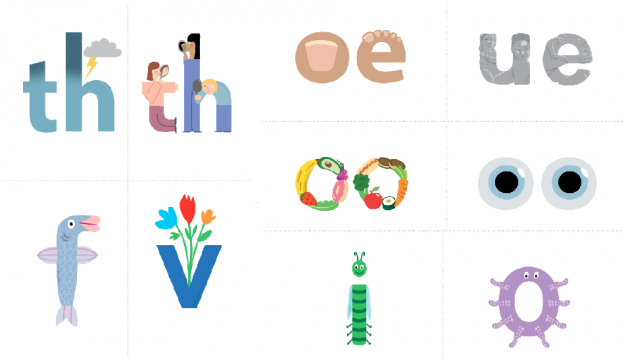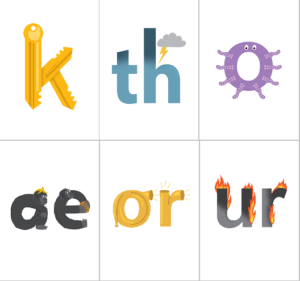New Embedded Picture Mnemonics now available
11 Replies
Despite a universe determined to throw spanners in my works, I’ve finally put artist Cat MacInnes’ new, improved version 2 Embedded Picture Mnemonics into the Spelfabet website shop. If you already bought version 1, you can now upgrade for free.
 Research has shown embedded picture mnemonics help children learn the relationships between speech sounds and letters.
Research has shown embedded picture mnemonics help children learn the relationships between speech sounds and letters.
There are now two versions of the Spelfabet Embedded Picture Mnemonics: one for speakers of Australian/British (non-rhotic) English, and one for speakers of American (rhotic) English. If you speak another version of English, download both files and mix and match to suit your accent.
Each set contains a mnemonic for each sound (phoneme) plus one for each of the three letters that represent the same sound as c (k, q, x). The pictures are now more relevant outside Australia, with k as in ‘key’ not ‘kangaroo’, ur as in ‘burn’ not ‘surf’ and u as in ‘up’ not ‘undies’ (I’m a little sad about the undies, so if you are too, just keep using the original mnemonic).
The sets now contain ‘o’ as in ‘octopus’, ‘ue’ as in ‘statue’, ‘or’ as in ‘horn’, ‘th’ as in ‘thunder’ and ‘themselves’, and ‘f’ as in ‘fish’ (no adjacent consonant). There are new ‘aw’ as in ‘claw’ and ‘wh’ as in ‘whale’ mnemonics in the US set. The relationship between ‘short’ and ‘long’ vowels is now clearer, as the ‘long’ vowels have a consistent format (ae, ee, ie, oe, ue).
Both the Aust/UK and US A4 poster size files can be found here. The pictures on them are now bigger, with less white space around them.
Both the Aust/UK and US A4 flashcard size files (four to a page) are here. Consonants are in portrait format and the vowels are in landscape format, which I hope helps children understand the difference between vowel and consonant sounds.
You can make and change words with these embedded picture mnemonics, using the flashcard size with individuals and small groups, like this:
Use the poster size mnemonics if doing this with a whole class, asking a child to hold each mnemonic you’ve taught and another child to rearrange them, while the rest of the class writes down the words thus created.
You can also use the mnemonics to build Sound Walls with your class, adding sounds and/or spellings as they are taught in your phonics teaching sequence, and refreshing the wordlists as new vocabulary is learnt, so that you might end up with mnemonics that look like this:

Teachers, therapists and others have already thought of lots of other great ways to use these mnemonics – too many to list here.
Thanks for the feedback and questions about version 1, which made me think about how to improve them. I hope you like Version 2, and thanks to the always-creative Cat MacInnes for her artistic talent, patience and hard work.
Steps for upgrading a previously-purchased file:
1. Go to the Spelfabet website and click on My Account.
2. Type in the email address you used for your original purchase, and the password you created. If you can’t remember your password, just reset it.
3. Go to the downloads area, click on the file(s) you want, and save it/them to your computer before printing. Ordinarily you get three chances to download any file from the online shop, in case of computer crashes or power outages, but I’ve increased this to four for these files in case some previous purchasers have used up their first three.
Any feedback or problems, email me on info@spelfabet.com.au.



I cannot find the American version of the embedded picture mnemonics on your site.
Hi Julie, the US and Aust/UK versions are both downloadable from both items (the A4 poster size and the flashcard size) in the website shop. They are nearly identical files, and some people might have accents that are a bit of a mixture of both and want to mix and match them, but otherwise you should just download the file that matches your accent.
Hello Alison,
I would like to know what you think about Speech Sound Pics approach? http://www.speechsoundpics.com
Maybe you have already addressed this program in a post, I can’t see it on your very helpful list of resource links.
Thanks so much for your time, cheers!
Carly
Hi Carly, the research shows that embedding letters into pictures is much better than pairing letters with pictures, which is what I think Speech Sound Pics does. I am aware of this program, and it does fall into the general category of explicit systematic phonics, but I have some concerns/reservations about it/its author which I can’t discuss publicly, sorry. Alison
Hi Alison,
Are you able to let us know what grapheme/phonemes are covered in these wonderful Mnemonics and if you are planning on covering alternate spellings of vowels?
Thank you
All the phonemes of standard Australian, UK and US English are in these sets, and I am only including one spelling of each. I’ll have a look in the shop where you’re from and email you the relevant list. Children should really only need these mnemonics for a short while and then once they can recognise all the letters and some common digraphs, they should be able to cope just with the letters.
Still can’t access my free copy of the updated Spelfabet cards. There is nothing in my downloads link even though the original version is the one product I have purchased from here. I’ve tried your recommended steps to access the news version to no avail. Any hints on where I’m going wrong please?
Dawn
So sorry about that, I have emailed you the file. I’m not sure why my website wouldn’t give it to you, am investigating. Alison
Can you please give information about the keyword picture/representation for the si grapheme? Thanks
Hi, yes, it’s the voiced palatal fricative sound in ‘Asia’, ‘vision’, ‘pleasure’, ‘beige’ and ‘gendarme’, it’s a voiced version of /sh/ that occurs mainly in Latin/French origin words. It’s not very common in English and it doesn’t occur at word beginnings, except in borrowed words like ‘gendarme’. Hope that makes sense, all the best, Alison
Hi Alison,
I have just purchased the poster sized file – I’ve looked through and the file still contains yoga for /y/ – does this mean I am not able to access the updated pictures?
Thanks so much in advance for your help, they are absolutely wonderful!
Lizzie